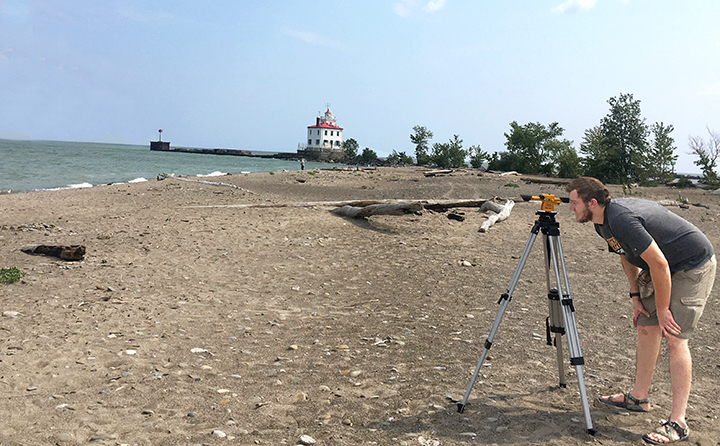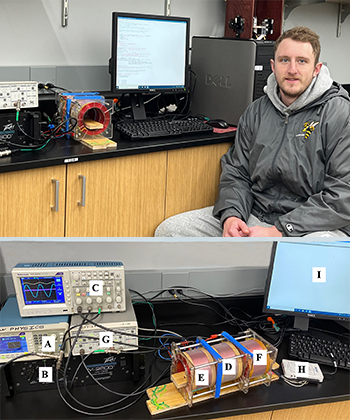Six beaches. Five professors. Four focused areas of study. And one student whose ingenuity and problem-solving acuity broke new ground in studying coastal sand along Lake Erie.

Clay Kolke '23 is an interdisciplinary guru - the type of student who melds intellect with passion and purpose to expand his STEM skills as well as career marketability. With his double majors in environmental science and physics and minors in biology and geology, he is well poised for achieving success.
And while the beaches of Lake Erie may be a calling card to sunbathers and nature enthusiasts, Kolke knew they had the perfect potential for a research study.
Kolke's research looks at the distribution of magnetite sand grains in beach deposits along Lake Erie. Scientifically speaking, magnetite is a type of iron oxide that is naturally occurring and has magnetic properties. It is more dense than typical sand sediment, so it requires more kinetic energy from wind and waves to move it.
The focus of the 18-month study was to determine the spatial distribution of magnetite across each beach transect and the magnetic susceptibility by grain size, which other studies have shown to be useful in identifying areas of erosion. The hypothesis was that magnetite would be concentrated in finer grains and, therefore, located in the landward portion of the beach, away from the constant energy of the waves.

Six Lake Erie beaches in Ohio were included in the study spanning the area from Toledo to Mentor. Kolke visited the sites and collected samples, which he then sieved to separate the sediment by grain size.
But there was a problem - which, for someone innovative like Kolke, transpired into a hands-on learning opportunity. In order to measure the degree of magnetization of the different types of sand sediment, he needed access to a magnetometer. So he did what any resourceful person would do - he built one!
With the help of his physics professor, Dr. Peter Hoekje, he designed, constructed and calibrated his own magnetometer using BW physics lab equipment. The experience not only provided him with much-need equipment for his study but also served as his senior thesis project.
Kolke also leaned on the expertise of biology assistant professor Dr. Andrew Merwin, who guided him in performing statistical analysis of the data to determine if there was a correlation between magnetite content and grain size and geographic distribution.
"I think this is a very exciting project," believes Dr. Carrie E. Davis Todd, who serves as BW's professor of geology and environmental science program coordinator. "Not only is there very little published research on this topic for Lake Erie's southern beaches, but also because Clay designed and built an instrument (using his physics knowledge), collected and analyzed sediment (using his geology knowledge), and now is conducting statistical tests (using his mathematical knowledge). It is a true interdisciplinary culmination of his BW coursework."
With the goal of publishing his research and attending graduate school to obtain a doctorate in geophysics, Kolke credits his BW professors for helping him achieve success. In addition to Hoekje, Davis Todd and Merwin, Kolke gives a special nod to Dr. Annette Trierweiler and Dr. Karen Munroe of the biology and geology department as well as his BW lacrosse coach Tony Tatro.
"Without them pushing, supporting and assisting me, I don't know where I'd be today," admits Kolke. "I was a very shy, introverted kid when I first came to BW. It wasn't easy to major in both disciplines, but I didn't quit on my dreams.
"My childhood dream was to work at NASA. I hope to make a positive impact on the world by using my passion for geology. This can be in fields of planetary science, volcanology, seismology or geophysics," noted the ambitious student from Medina, Ohio.
"My research project provided an experience not found in a classroom setting," explained Kolke. "My advice to anyone having a goal who may not be exactly sure how to achieve it - follow your passion and never back away from a challenge."